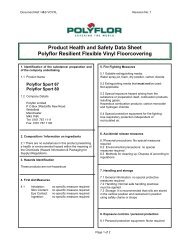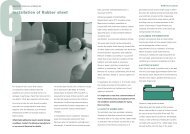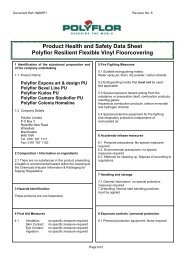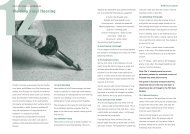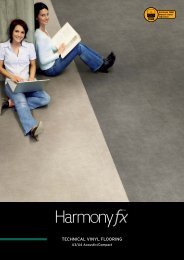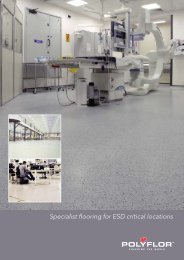floorcoverings - Polyflor
floorcoverings - Polyflor
floorcoverings - Polyflor
Create successful ePaper yourself
Turn your PDF publications into a flip-book with our unique Google optimized e-Paper software.
POLYFLOR TECHNICAL INFORMATION<br />
WWW.POLYFLOR.COM<br />
extend along the floor for 150mm (Figure 20).<br />
5.4.3 <strong>Polyflor</strong> Conductive Floorcoverings<br />
With this type of flooring, an earthing grid of the<br />
correct size strip (50mm wide, 0.1mm thick) is<br />
essential. The strip is laid 150mm from one side of<br />
the room and is connected to a known earth (Figure<br />
21). A second strip is laid at 90° to the fırst strip,<br />
When the adhesive is tacky, the vinyl sheet should be<br />
accurately re-laid, ensuring it does not twist or trap<br />
air bubbles. Seams must be without gaps and any<br />
excess adhesive should be removed as work<br />
proceeds. The vinyl sheet is then rolled with a 68kg<br />
articulated floor roller in the short direction fırst,<br />
then the long, and the rolling repeated between one<br />
and four hours later.<br />
EARTH<br />
GRID SPACING<br />
150mm<br />
600mm<br />
APPROX<br />
Figure 21 Earthing strip layout<br />
150mm<br />
APPROX<br />
EARTH<br />
5.5.2 ESD Vinyl Tiles<br />
<strong>Polyflor</strong> ESD vinyl tiles are installed by the same<br />
method as standard vinyl tiles – the single stick<br />
method. The grid layout for static control tiles is the<br />
same as for sheet vinyl, as described previously.<br />
across the full width of the room, and 150mm from<br />
the edge of the room. Further strips are laid in a<br />
rectangular grid, 600mm apart, as shown on<br />
figure 21. It is important that the layout of the<br />
grid is confirmed with the end user as there are<br />
variations in the requirement for some military<br />
specifications.<br />
5.5 INSTALLATION METHODS<br />
The basic techniques for installation of <strong>Polyflor</strong> ESD<br />
<strong>floorcoverings</strong> are the same as described for<br />
standard vinyl sheet and tile in Sections 3 and 4<br />
respectively. However, there are a number of<br />
important differences:<br />
5.5.1 ESD Vinyl Sheet<br />
<strong>Polyflor</strong> ESD vinyl sheet should be installed by the<br />
double drop method. This is because the conductive<br />
adhesive contains carbon, which results in low tack.<br />
Once the adhesive has been spread, the vinyl sheet<br />
is laid into it and pressed all over to ensure an even<br />
transfer of adhesive. The vinyl sheet is then folded<br />
Note: ESD vinyl tiles must always be heat welded.<br />
See Section 8.<br />
5.6 SPECIAL PRECAUTIONS<br />
Special precautions must be taken with the following<br />
products:<br />
5.6.1 Electrostatic Conductive (EC) Floorcoverings<br />
Pipes or metal projections (e.g. metal gullies, door<br />
spring plates etc.) must be insulated from the EC<br />
floorcovering and free from conductive adhesive.<br />
The following method of installation is recommended.<br />
The EC floorcovering should be cut 50mm short of<br />
any pipe or metal fixture. This infill area should be<br />
laid with a suitably coloured standard <strong>Polyflor</strong> sheet<br />
vinyl, adhered with a non-conductive adhesive.<br />
This infill piece should then be welded to the ESD<br />
floorcovering with a standard weld rod.<br />
5.6.2 Conductive Floorcovering<br />
It is recommended that, as a permanent record, a<br />
brass plate be countersunk into the floor in a suitable<br />
position. The plate should be engraved as follows:<br />
back and left until the adhesive becomes tacky.



